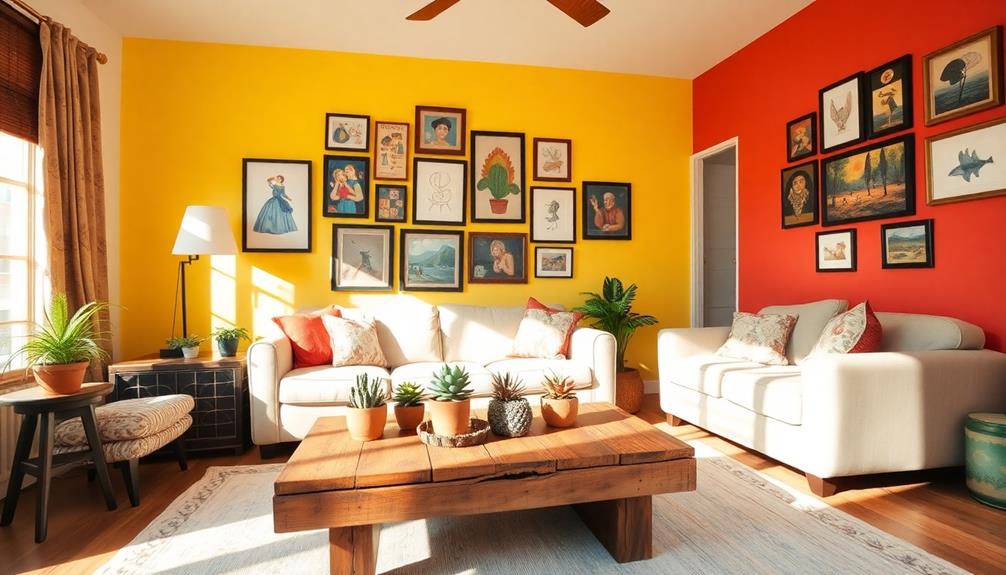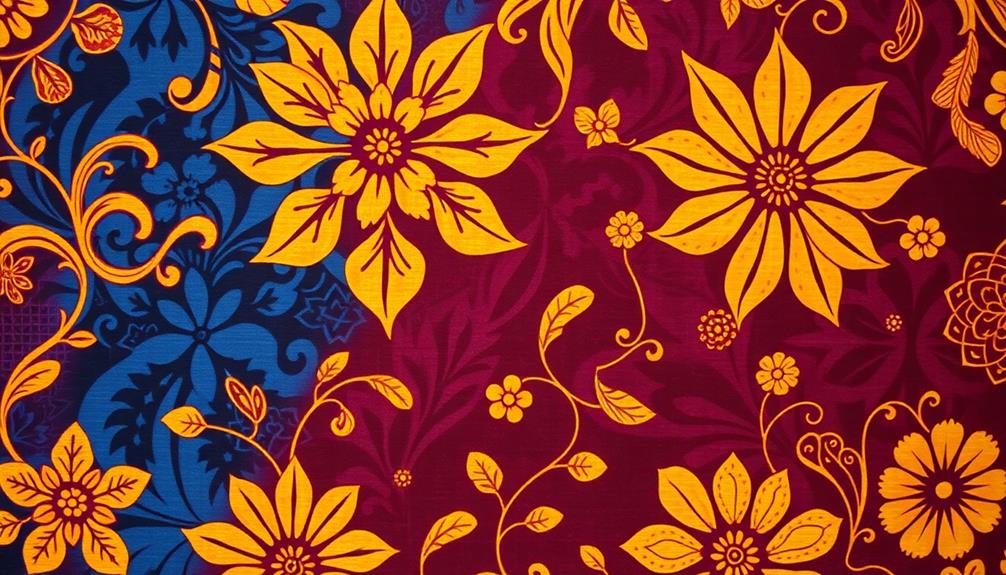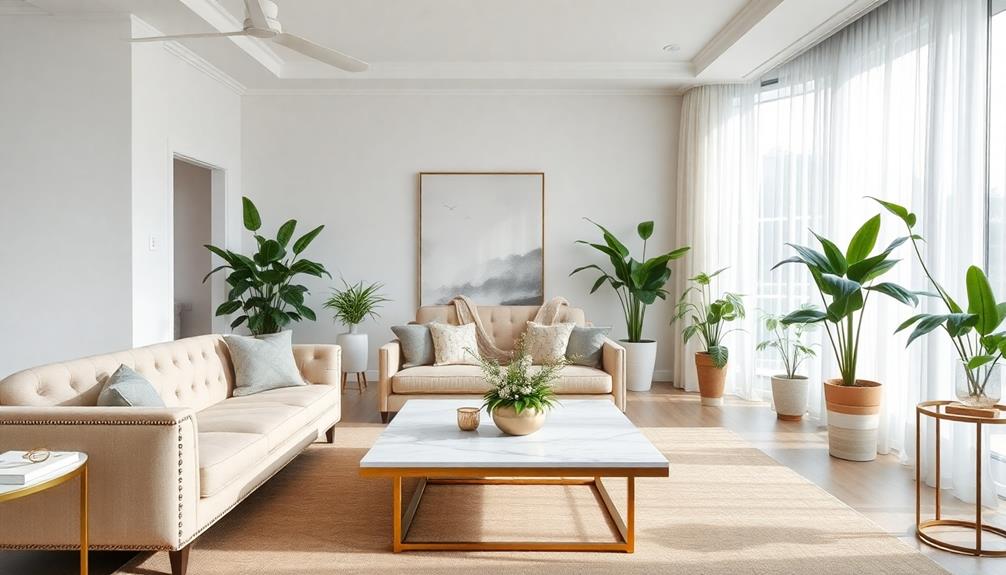To create a luxurious and serene Balinese-style house, start by using natural materials like wood, stone, and bamboo. Embrace vibrant colors mixed with earthy tones to reflect Bali's beauty. Focus on open spaces that invite natural light and airflow. Incorporate water features, such as ponds or fountains, to enhance tranquility. Furnish your home with handcrafted wooden furniture, vibrant textiles, and cultural artifacts for authenticity. Design outdoor spaces that seamlessly blend with lush landscaping and native plants. These elements will help you cultivate that serene atmosphere. Stay with us to explore more inspiring tips for your Balinese oasis! When it comes to creating a luxurious and serene Balinese-style house, the key is to embrace the principles of Bali style interior design. This means focusing on creating a harmonious and peaceful living space that connects with nature. By incorporating traditional Balinese design elements, such as intricate carvings and natural fibers, you can achieve an authentic and inviting atmosphere that reflects the spirit of Bali. With the right attention to detail and a dedication to embracing the beauty of Bali, you can create a truly stunning and serene home. To truly capture the essence of Balinese style, it’s important to blend modern and island charm seamlessly. This can be achieved by incorporating modern amenities and technology into the design while still maintaining the traditional aesthetic. By striking a balance between the two, you can create a luxurious and serene retreat that offers the best of both worlds. With careful consideration and thoughtful design choices, your Balinese-style house can become a haven of tranquility and elegance.
Key Takeaways
- Embrace natural materials like wood, stone, and bamboo to create a serene and harmonious environment that reflects Balinese aesthetics.
- Incorporate vibrant colors and intricate patterns in textiles and decor to evoke the beauty of Bali's landscapes.
- Design open spaces that promote airflow and natural light, enhancing tranquility and a sense of connection to nature.
- Add water features such as ponds or fountains to create a calming ambiance, enriching the serene atmosphere of your home.
- Choose handcrafted wooden furniture and cultural artifacts to celebrate Balinese craftsmanship and add warmth and authenticity to your space.
Principles of Balinese Decor

When you embrace Balinese decor, you'll find that its principles are rooted in harmony with nature. This design philosophy focuses on creating a tranquil and serene environment, utilizing natural materials like wood, stone, and bamboo. These elements not only enhance the aesthetic but also invite the outdoors into your living space, fostering a strong connection between interior and exterior environments.
Incorporating natural ventilation for comfort further promotes a revitalizing atmosphere throughout your home.
Vibrant colors and intricate patterns play an essential role in Balinese design. You'll notice a warm, earthy color palette that reflects the beautiful landscapes of Bali, providing a soothing backdrop for your home. Open spaces are vital, as they promote airflow and natural light, allowing for a seamless shift between indoor and outdoor living.
Incorporating water features, like ponds and fountains, adds a calming element, connecting your home to its natural surroundings and enhancing the peaceful ambiance.
Traditional craftsmanship shines through in handcrafted wooden furniture and culturally significant art pieces, serving as unique focal points that tell a story. By following these principles, you can create a living space that feels luxurious yet deeply connected to the beauty of nature, embodying the essence of Balinese decor.
Natural Materials and Textures

Balinese decor thrives on the use of natural materials and textures that enhance its serene aesthetic. By incorporating elements like bamboo, rattan, and various woods, you can create a space that resonates with natural beauty.
These materials aren't just sustainable; they also reflect traditional Balinese craftsmanship, enriching your home with cultural significance. This approach aligns perfectly with the expertise offered by Mahallati Interiors in creating luxurious tropical designs.
Consider these key materials and textures to elevate your decor:
- Bamboo and Rattan: Perfect for furniture, they add a tropical vibe and seamlessly blend indoor and outdoor spaces.
- Teak and Suar Wood: These woods add rustic charm to your furnishings, enhancing the tranquil ambiance.
- Stone Accents: Use stone for flooring or garden features to complement natural materials and create harmony.
- Textiles: Incorporate linen and cotton to mix textures, fostering a calming atmosphere.
Color Palette Selection

A thoughtfully selected color palette can transform your home into a serene Balinese retreat. To achieve the calming atmosphere characteristic of Bali interior design, start with earthy tones like whites, browns, greens, and terracotta. These colors reflect Bali's natural landscapes and create a tranquil environment.
You can enhance this peaceful backdrop with vibrant accent colors such as turquoise, red, and gold. These shades add liveliness while still keeping the minimalist aesthetic that Balinese design embodies. Remember, neutral backgrounds are essential as they provide a serene canvas for your decorative elements, evoking relaxation.
Here's a simple color palette guide to inspire you:
| Primary Colors | Accent Colors |
|---|---|
| Whites | Turquoise |
| Browns | Red |
| Greens | Gold |
| Terracotta | Vibrant Tropical Hues |
Using natural dyes for fabrics and wall treatments aligns with eco-friendly practices, preserving the authenticity of your Balinese-inspired home. By thoughtfully selecting your color palette, you'll create a luxurious yet serene sanctuary that echoes the beauty of Bali.
Furniture and Accessory Choices

When you're choosing furniture for your Balinese-style house, handcrafted wooden pieces should be at the top of your list, as they offer both beauty and cultural significance.
Incorporating vibrant colors and intricate patterns through Indonesian decorative pillows will enhance the overall aesthetic while providing comfort.
Additionally, incorporating rattan and wicker accents will enhance the tropical vibe while keeping things relaxed.
Don't forget to add cultural artifacts and textiles to create a space that feels authentic and inviting.
Handcrafted Wooden Furniture
Often, handcrafted wooden furniture plays an essential role in defining the essence of a Balinese-style home.
These pieces, often made from sustainable materials like teak and suar wood, aren't only durable but also showcase the natural beauty of the wood. The intricate carvings and unique designs reflect the rich cultural heritage of Bali, turning each piece into a work of art that adds to the aesthetic appeal of your space.
Incorporating unique elements such as Indonesian decor masks can further enhance the cultural vibe of your home.
To create a harmonious atmosphere, consider the following furniture options:
- Low-profile seating: Daybeds and poufs encourage a relaxed vibe, perfect for unwinding.
- Multi-functional pieces: Tables with storage or convertible seating maximize space while maintaining style.
- Intricate designs: Look for furniture that showcases traditional craftsmanship, enhancing your home's character.
- Natural finishes: Choose pieces with minimal varnish to highlight the wood's inherent beauty.
Rattan and Wicker Accents
Incorporating rattan and wicker accents into your Balinese-style home instantly elevates the decor while enhancing its tropical charm. These materials are lightweight yet durable, making them perfect for furniture that complements the serene aesthetic. Handwoven rattan chairs and tables often showcase intricate patterns, reflecting the skills of local artisans and adding a touch of cultural heritage to your space.
By opting for pieces from top shopping destinations, you can guarantee that your selections highlight sustainable craftsmanship and unique designs.
Wicker accents, such as baskets and decorative items, enrich your home with texture and warmth. They blend seamlessly with the earthy tones typical of Balinese design, creating a cohesive look. Multi-functional rattan furniture, like storage ottomans and coffee tables, not only maximizes space efficiency but also maintains a relaxed and inviting atmosphere, essential for a tropical retreat.
To further amplify your decor, consider adding rattan and wicker accessories like throw pillows and rugs. These elements introduce layers of comfort and style, enhancing the overall tranquil environment.
Cultural Artifacts and Textiles
Cultural artifacts and textiles play an essential role in defining the aesthetic of a Balinese-style home. Incorporating handcrafted wooden furniture with intricate carvings not only serves as a focal point but also reflects the rich cultural heritage of Balinese craftsmanship.
These elements create a warm and inviting atmosphere while celebrating local artistry. To further enhance your decor, consider adding vibrant Indonesian decor masks, which showcase the island's unique designs and storytelling traditions, providing an additional layer of cultural richness to your space (traditional artistry).
To enhance your space, consider the following choices:
- Traditional textiles: Use batik and ikat for cushions and throws, adding vibrant patterns that evoke Bali's natural beauty.
- Decorative accessories: Incorporate Balinese masks and figurines to showcase the island's mythology and artistic expressions.
- Statement pieces: Bold sculptures or local artwork can serve as eye-catching focal points, enriching your overall design aesthetic.
- Comfortable furniture: Rattan and wicker pieces promote a tropical feel while aligning with Balinese values of relaxation and harmony with nature.
Outdoor Spaces and Landscaping

When you step into a Balinese-style house, the outdoor spaces and landscaping immediately draw you in, creating a harmonious connection with nature. Tropical gardens filled with native plants and colorful flowers enhance the vibrant atmosphere, reflecting Bali's natural beauty.
The design often emphasizes the importance of blending indoor and outdoor environments, fostering a seamless changeover that promotes tranquility and relaxation. You'll find pathways made of natural stones guiding you through these lush gardens, ensuring a seamless changeover between your indoor and outdoor spaces.
Water features, like ponds or fountains, are essential elements that promote tranquility. The soothing sound of flowing water creates a calming auditory backdrop, inviting relaxation.
Outdoor living areas, such as patios and decks, are perfect for unwinding or socializing, often furnished with low-profile seating made from natural materials like rattan and wood. This approach aligns with the focus on sustainability and eco-friendly practices found in modern tropical aesthetics.
Balinese-style pools, whether they're infinity pools or natural swimming ponds, integrate seamlessly into the landscape. These luxurious spaces not only provide recreation but also enhance the serene ambiance of your home.
Sustainable Design Practices

When designing your Balinese-style home, consider using eco-friendly materials like bamboo and reclaimed wood to minimize your environmental impact.
Incorporating sustainable design practices such as natural ventilation and passive solar techniques can greatly enhance energy efficiency. You can also enhance energy efficiency by incorporating strategies like natural ventilation and solar panels.
Eco-Friendly Materials Selection
Choosing eco-friendly materials for your Balinese-style home is essential for creating a sustainable living environment. By selecting natural and sustainable options, you not only enhance the aesthetic appeal of your home but also promote ecological responsibility.
Incorporating elements of traditional Indonesian houses can further enrich your design, as these structures reflect a deep connection to nature and local culture. Here are some key materials to reflect upon:
- Bamboo: Strong, versatile, and rapidly renewable, bamboo is a fantastic choice for construction and decor.
- Reclaimed wood: This material reduces deforestation, promotes waste reduction, and adds unique character to your furniture and accents.
- Natural stone: Sourced locally, natural stone minimizes transportation emissions and beautifully blends with the surrounding landscape.
- Eco-friendly paints and finishes: Opt for finishes made from natural pigments, free of harmful chemicals, ensuring a healthier indoor environment.
Incorporating these materials aligns your home with the eco-conscious living principles inherent in Balinese culture.
Additionally, contemplate implementing solar panels and rainwater harvesting systems to further enhance sustainability. By making these choices, you create a luxurious yet serene space that respects nature and promotes a healthier lifestyle.
Energy Efficiency Strategies
Incorporating energy efficiency strategies into your Balinese-style home can greatly enhance its sustainability while reducing costs. By utilizing passive design strategies, like cross-ventilation and natural shading, you can lower the need for artificial cooling, potentially saving up to 30% on energy in tropical climates.
Additionally, embracing traditional Indonesian style home decor can enhance your home's natural appeal while promoting energy efficiency.
Consider installing solar panels for renewable energy generation. This not only decreases reliance on grid power but can also cut your energy costs by 50% or more over time.
Implementing rainwater harvesting systems allows you to capture and reuse rainwater, minimizing water consumption for irrigation and household needs.
When selecting building materials, choose eco-friendly options such as bamboo and reclaimed wood. These materials lower your construction's carbon footprint and improve thermal efficiency, helping maintain stable indoor temperatures.
Lastly, designing your landscape with local flora not only supports biodiversity but also requires less irrigation and maintenance, contributing to your home's overall energy efficiency.
Native Plant Landscaping
Native plant landscaping is a powerful way to enhance the beauty and sustainability of your Balinese-style home. By choosing native plants, you're not just adding vibrant colors and textures; you're also promoting biodiversity and creating a natural habitat for local wildlife.
Native species are adapted to your local climate, requiring less water and maintenance than non-native varieties, which makes your garden more eco-friendly.
Here are some benefits of incorporating native plant landscaping:
- Biodiversity: Supports a rich ecosystem by attracting local wildlife like birds and butterflies.
- Soil Health: Deep root systems improve soil quality and prevent erosion.
- Water Efficiency: Native plants typically need less watering, saving you time and resources.
- Low Maintenance: Reduces the need for chemical fertilizers and pesticides, promoting a healthier garden environment.
Frequently Asked Questions
How Do I Make My House Feel Like Bali?
To make your house feel like Bali, incorporate natural materials, use earthy colors, design open spaces for airflow and light, add water features, and showcase handcrafted furniture and local art for authenticity and luxury.
What Are the Characteristics of Balinese Houses?
Did you know that over 70% of Balinese homes incorporate open designs? You'll find large windows, natural materials, and tranquil water features that connect indoor and outdoor spaces, creating a serene atmosphere you'll love.
What Is the Balinese Home Architecture?
Balinese home architecture emphasizes open layouts, allowing natural light and airflow. Using sustainable materials like bamboo and stone, it features high ceilings, thatched roofs, and tranquil water elements, creating a harmonious connection with nature that you'll love.
What Is a Traditional Balinese House Called?
Ever wondered what a traditional Balinese house is called? It's known as a "rumah adat." This unique dwelling reflects the culture, featuring open-air designs and intricate carvings that celebrate Balinese mythology and artistry.
Conclusion
Creating a Balinese-style home isn't just about aesthetics; it's about crafting a sanctuary that nurtures your spirit. By embracing natural materials, a harmonious color palette, and thoughtful outdoor spaces, you invite tranquility into your life. Are you ready to transform your living space into a luxurious retreat? With sustainable design practices guiding your choices, you'll not only enhance your home's beauty but also foster a deeper connection with nature and serenity. Your dream oasis awaits!









